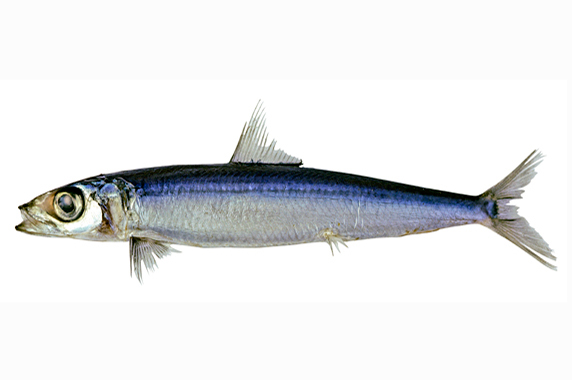- Classification
- ACTINOPTERYGII
- CLUPEIFORMES
- CLUPEIDAE
- Etrumeus
- jacksoniensis
Maray, Etrumeus jacksoniensis Macleay 1878
Other Names: Northern Herring, Red-eye Round Herring, Round Herring

Maray, Etrumeus jacksoniensis, from off New South Wales. Source: Ken Graham / NSW Fisheries. License: All rights reserved
Summary:
A dark blue to olive green herring grading to silvery below, with the pelvic fins originating behind the rear of the dorsal-fin base.
In Australia, this species was previously known as Etrumeus teres. DiBattista et al. (2014) found the Australian round herring to be genetically distinct from other species of Etrumeus in the Indian and Pacific Oceans - and resurrected the name E. jacksoniensis.
In Australia, this species was previously known as Etrumeus teres. DiBattista et al. (2014) found the Australian round herring to be genetically distinct from other species of Etrumeus in the Indian and Pacific Oceans - and resurrected the name E. jacksoniensis.
Cite this page as:
Bray, D.J. 2023, Etrumeus jacksoniensis in Fishes of Australia, accessed 27 Jun 2025, https://fishesofaustralia.net.au/Home/species/2052
Maray, Etrumeus jacksoniensis Macleay 1878
More Info
|
Distribution |
E of Fraser Island, Queensland, to the Houtman Abrolhos, Western Australia. Although Maray occur in estuarine and coastal waters, they usually form large shoals, often at considerable distances from shore. |
|
Features |
Dorsal fin 18-21; anal fin 9-12; Caudal fin 15-17; Pectoral fin 15-16: Pelvic fin 10. Body shallow (16-20% SL), elongate, oval in cross section, tapering gradually to slender caudal peduncle. Head small (24-29% SL); eyes large (24-34% HL), prominent transparent adipose tissue covering eye and practically all of snout laterally; mouth small (upper jaw length 33-39% HL), oblique, maxillae broad, reaching to below forward edge of eye; teeth tiny, in single row on lower jaw only. Scales moderately small, cycloid, weakly attached, covering body but absent from head, 48-56 oblique rows on sides, those on back and underside not compressed into keel; lateral line absent. Dorsal fin with short base located centrally on back, anterior rays much longer than posterior rays; anal fin very low and short, located near caudal fin; caudal fin deeply forked. Pectoral and pelvic fins small, each with prominent axillary tissue, pectorals on ventral profile of body just behind head; pelvic fins arising immediately behind vertical through posterior end of dorsal-fin base. |
|
Fisheries |
Marray do not appear to have been commercially fished at any time. |
|
Remarks |
Although Maray are not often encountered because of their preference for deeper waters, they are an important food source for squid and other fishes. |
|
Etymology |
Named jacksoniensis for Port Jackson, the type locality. |
|
Species Citation |
Etrumeus jacksoniensis Macleay, 1878, Proc. Linn. Soc. N. S. W. 1 3(1): 36, pl. 4(1). Type locality: Port Jackson, NSW. |
|
Author |
Bray, D.J. 2023 |
|
Resources |
Atlas of Living Australia (as Etrumeus teres) |
Maray, Etrumeus jacksoniensis Macleay 1878
References
DiBattista, J.D., Randall, J.E., Newman, S.J. & Bowen, B.W. 2014. Round herring (genus Etrumeus) contain distinct evolutionary lineages coincident with a biogeographic barrier along Australia’s southern temperate coastline. Marine Biology 161(11): 2465-2477 https://doi.org/10.1007/s00227-014-2516-5
DiBattista, J.D., Randall, J.E. & Bowen, B.W. 2012. Review of the round herrings of the genus Etrumeus (Clupeidae: Dussumieriinae) of Africa, with descriptions of two new species. Cybium 36 3: 447-460.
Di Dario, F. 2017. Etrumeus jacksoniensis . The IUCN Red List of Threatened Species 2017: e.T114164022A114164046. http://dx.doi.org/10.2305/IUCN.UK.2017-3.RLTS.T114164022A114164046.en. Downloaded on 17 December 2019.
Gomon, M.F. 1994. Families Halosauridae, Notacanthidae, Clupeidae, Engraulidae, Gonorynchidae, Plotosidae, Salmonidae. pp. 215-231 figs 192-206 in Gomon, M.F., Glover, C.J.M. & Kuiter, R.H. (eds). The Fishes of Australia's South Coast. Adelaide : State Printer 992 pp. 810 figs. (as Etrumeus teres)
Gomon, M.F. 2008. Clupeidae and Engraulidae. pp. 187-194 in Gomon. M.F., Bray, D.J. & Kuiter, R.H (eds). Fishes of Australia's Southern Coast. Sydney : Reed New Holland 928 pp. (as Etrumeus teres)
Grant, E.M. 2002. Guide to Fishes. Redcliffe : EM Grant Pty Ltd 880 pp.Hutchins, J.B. 2001. Checklist of the fishes of Western Australia. Records of the Western Australian Museum, Supplement 63: 9-50. (as Etrumeus teres)
Macleay, W.J. 1878. Descriptions of some new fishes from Port Jackson and King George's Sound. Proceedings of the Linnean Society of New South Wales 1 3(1): 33-37 pls 2-5 See ref at BHL
Munro, I.S.R. 1961. Handbook of Australian fishes. Nos 1–42. Australian Fisheries Newsletter 15–17, 19, 20: 1-17 (as Etrumeus teres)
Paxton, J.R., Gates, J.E., Bray, D.J. & Hoese, D.F. 2006. Clupeidae. pp. 323-336 in Hoese, D.F., Bray, D.J., Paxton, J.R. & Allen, G.R. Fishes. In, Beesley, P.L. & Wells, A. (eds) Zoological Catalogue of Australia. Vol. 35. Volume 35 Australia : ABRS & CSIRO Publishing Parts 1-3, 2178 pp. (as Etrumeus teres)
Whitehead, P.J.P. 1963. A revision of the recent round herrings (Pisces : Dussumieriidae). Bulletin of the British Museum (Natural History) Historical Series 10(6): 305-380 figs 1-33 (as Etrumeus teres)
Whitehead, P.J.P. 1985. FAO species catalog. Clupeoid fishes of the world (suborder Clupeoidei). Part 1 — Chirocentridae, Clupeidae and Pristigasteridae. FAO Fisheries Synopsis No. 125 Vol. 7 Pt 1. pp. 1-303 (as Etrumeus teres)



